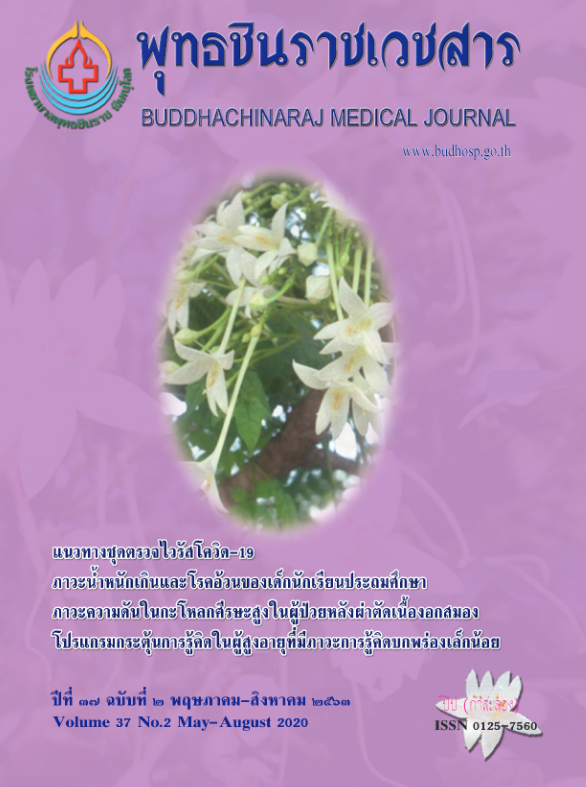ผลการปฏิรูปการดูผู้ป่วยข้างเตียงต่ออุบัติการณ์การถอดท่อช่วยหายใจโดยไม่ได้วางแผน
ผลการปฏิรูปการดูแลผู้ป่วยข้างเตียงต่อการถอดท่อช่วยหายใจโดยไม่ได้วางแผน
คำสำคัญ:
การปฏิรูปการดูแลผู้ป่วยข้างเตียง, การพยาบาลผู้ป่วย, การถอดท่อช่วยหายใจโดยไม่ได้วางแผนบทคัดย่อ
การปฏิรูปหรือการเปลี่ยนแปลงการดูแลผู้ป่วยที่ข้างเตียงมีเป้าหมายเพื่อพัฒนาคุณภาพการดูแลผู้ป่วยให้ปลอดภัยมากยิ่งขึ้น การ วิจัยแบบกึ่งทดลองครั้งนี้มีวัตถุประสงค์เพื่อเปรียบเทียบอุบัติการณ์การถอดท่อช่วยหายใจโดยไม่ได้วางแผนก่อนและหลังการใช้ แนวปฏิบัติการพยาบาลผู้ป่วยแบบ TCAB ในหอผู้ป่วยหนักอายุรกรรม 1 โรงพยาบาลพุทธชินราช พิษณุโลก ศึกษาในกลุ่มควบคุม คือ กลุ่มที่ได้รับการดูแลตามมาตรฐานเดิมระหว่างเดือน เมษายน-กันยายน พ.ศ. 2560 จำนวน 150 รายและกลุ่มทดลอง คือ กลุ่มที่ ใช้แนวปฏิบัติการพยาบาลผู้ป่วยแบบ TCAB ระหว่างเดือนตุลาคม 2560-มีนาคม พ.ศ. 2561 จำนวน 150 ราย เครื่องมือที่ใช้ในวิจัย ได้แก่ (1) แนวปฏิบัติ การพยาบาลผู้ป่วยแบบ TCAB ประกอบด้วย 4 ส่วน ได้แก่ การพยาบาลผู้ป่วยแบบ TCAB, การดูแลผู้ป่วยที่ใส่ ท่อช่วยหายใจ, การจัดการอาการเจ็บปวดไม่สุขสบายและการให้ยากล่อมประสาท และการผูกยึดผู้ป่วย (2) แบบบันทึกข้อมูล แบ่ง เป็น 3 ส่วน ได้แก่ แบบบันทึกข้อมูลส่วนบุคคล, แบบประเมินผู้ป่วยตามแนวปฏิบัติฯ TCAB, แบบบันทึกอุบัติการณ์การถอดท่อช่วย หายใจโดยไม่ได้วางแผน นำเสนอข้อมูลเป็นค่าความถี่ ค่าร้อยละ และ ค่าเฉลี่ย เปรียบเทียบข้อมูลระหว่างกลุ่มทดลองและกลุ่ม ควบคุมด้วยการทดสอบ chi-square กำหนดระดับนัยสำคัญ ทางสถิติที่ 0.05 ผลการศึกษาพบว่าการใช้แนวปฏิบัติการพยาบาลผู้ ป่วยแบบ TCAB ลดอุบัติการณ์การถอด ท่อช่วยหายใจโดยไม่ได้วางแผนอย่างมีนัยสำคัญทางสถิติ สรุปได้ว่าควรนำแนวปฏิบัติฯ แบบ TCAB นี้ไปพัฒนากระบวนการพยาบาลผู้ป่วยด้านอื่น ๆ ให้เกิดความปลอดภัยต่อผู้ป่วยต่อไป
เอกสารอ้างอิง
2. Lee JH, Lee HC, Jeon YT, Hwang JW, Lee H, Oh HW, et al. Clinical outcomes after unplanned extubation in a surgical intensive care population. World J Surg 2014;38(1):203-10.
3. Piriyapatsom A, Chittawatanarat K, Kongsayreepong S, Chaiwat O. Incidence and risk factors of unplanned extubation in critically ill surgical patients: The Multicenter Thai University-based Surgical Intensive Care Units Study (THAI-SICU Study). J Med Assoc 2016;99(Suppl 6):153-62.
4. Norakhun S, NamjuntraR, BinhosenV. The effect of nursing care protocol on the incidence rates of unplanned extubation in patients with endotracheal intubation. Thai J Cardiothoracic Nurs 2016;27(1): 72-84.
5. Song YG, Yun EK. Model for unplanned self extubation of ICU patients using system dynamics approach. J Korean Acad Nurs 2015;45(2):280-92.
6. Cho HI, Lee YW, Kim HS, Sim BY. Comparison of related characteristics between unplanned and planned extubation of patients in medical intensive unit. Korean J Adult Nurs 2012;24(5):509-19.
7. Choi YS, Chae YR. Effects of rotated endotracheal tube fixation method on unplanned extubation, oral mucosa and facial skin integrity in ICU patients. J Korean Acad Nurs 2012;42(1):116-24.doi: 10.4040/jkan.2012.42.1.116
8. Kedsumpun Y. Transforming care at bedside. Bangkok: Faculty of Medicine, Siriraj Hospital [Internet]. 2013 [cited 2018 March 4]. Available from: https://www.si.mahidol. ac.th/Th/division/nursing/NDivision/N_qd/admin/news_files/54_72_1.pdf
9. Thailand Nursing and Midwifery Council. Nursing and Midwifery Standard [Internet]. 2001 [cited 2016 June 25]. Available from: http://law.longdo.com/law/535/sub40058
10. Medical Intensive Care Unit 1, Buddhachinaraj Phitsanulok Hospital. Annual Report 2017. Phitsanulok: Medical Intensive Care Unit 1, Buddhachinaraj Phitsanulok Hospital; 2018.
11. Srisatidnarakul B. The methodology in nursing research. 5th ed. Bangkok: U&I Intermedia Company; 2010.
12. Knaus WA, Draper EA, Wagner DP, Zimmerman JE. APACHE II: A severity of disease classification system. Crit Care Med 1985;13(10):818-29.
13. Ely EW. ICU delirium and cognitive impairment study group [serial on the Internet]. 2010 [cited 2014 June 25]; Available from:http://www.mc.vanderbilt.edu/icudelirium/docs/CAM_ICU_training.pdf
14. Potaya S. The Glasgow Coma Scale. J Royal Thai Army 2018;19(1):30-38.
15. Wachirasawat N, Ratchakuls. Effect of transforming care at bedside program on job satisfaction of staff nurse and nursing error rate at critical care unit of Samitivaj Sukhumvit Hospital. J Royal Thai Army 2010;11(1):30-6.
16. Dearmon V, Roussel L, Buckner E, Mulekar M, Pomrenke B, Brown A, et al. Transforming Care at the Bedside (TCAB): Enhancing direct care and value-added care. Nurs Manag [serial on the Internet]. 2013 [cited 2017 June 25];21(4):668-78. Available from: CINAHL Plus with Full Text
17. Vasilevskis EE. Delirium and sedation recognition using validated instrument: Reliability of bedside intensive care unit nursing assessment from 2007-2010. JAGS 2011;59(s2):249-55.






